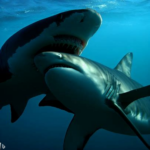
Key Takeaways
- Great white sharks are currently listed as vulnerable, meaning they are at risk of becoming endangered in the near future.
- Overfishing and habitat destruction are the main threats to great white shark populations.
- The decline in their prey species, such as seals and sea lions, also contributes to the endangerment of great white sharks.
- Conservation efforts, such as protected marine areas and fishing regulations, are crucial for the survival of great white sharks.
- Public awareness and education about the importance of these apex predators are essential for their conservation.
- Further research and monitoring are needed to better understand the population dynamics and behavior of great white sharks.
Are Great White Sharks endangered? We must delve into their population and conservation efforts to truly understand. The main cause of decline: overfishing. High demand for shark products, coupled with accidental catch in nets, threatens their future.
The disappearance of this species affects the entire marine ecosystem. They control prey populations, and regulate their habitats. Without them, the oceanic food web could be destroyed.
It is now essential to take immediate action. Strict regulations on fishing and trade must be put in place. Public awareness campaigns can help dispel misconceptions and gain support for conservation.
Let us come together to save the Great White Shark! It’s not just about preserving a species; it’s about safeguarding the future of our oceans and ensuring ecological harmony. Let’s ensure these iconic predators remain forever in nature’s greatest marvels.
Background on Great White Sharks

To understand the background on great white sharks and gain insights into their conservation status, delve into the section “Description and Habits of Great White Sharks.” This sub-section provides valuable information about the physical characteristics, behaviors, and habitat preferences of these majestic creatures, shedding light on their fascinating existence.
Description and Habits of Great White Sharks
Great White Sharks boast sharp teeth, a grey upper body, and a pale underbelly. They have some unique behaviors too, like an ambush hunting strategy and breaching out of water to catch prey. Plus, they can regulate their body temperature, allowing them to survive in different environments.
In the past, media portrayals of Great White Sharks led to many misconceptions. But, now that scientists have done more research and collected data, we know more about their behaviors patterns, migratory routes, and ecological significance.
We owe much of our knowledge of Great White Sharks to the tireless efforts of researchers and conservationists. Through their hard work, we’ve gained greater awareness of the importance of preserving marine ecosystems and protecting this species for future generations.
Current Status and Threats

To understand the current status and threats surrounding great white sharks, delve into the sub-sections: population decline and endangered status, human interactions and impact. Explore the causes behind their decreasing numbers and the adverse effects of human activities on these majestic creatures.
Population Decline and Endangered Status
The population of many species is in rapid decline, making them vulnerable and endangered. This alarming reduction calls for urgent action to prevent further harm.
- The numbers have dropped drastically, with factors such as habitat loss, poaching, and climate change contributing to the problem.
- Unless immediate measures are taken, these species may become extinct. The speedy destruction of their habitats puts them at risk, leaving them exposed to a variety of threats.
- In addition, their dwindling population can disrupt ecological balances, impacting other organisms in the ecosystem. This could have far-reaching effects, affecting biodiversity and ecosystem functioning on a large scale.
- To tackle this challenge, global collaboration is essential. Governments, conservation organizations, and individuals must work together to implement strict regulations, promote sustainable practices, and spread awareness about these endangered species.
It is not just a scientific issue; it is our moral responsibility to protect our planet’s biodiversity. By taking action now and shielding these species from further decline, we can guarantee the preservation of our natural heritage for future generations. Let us do our part to protect these vulnerable creatures and maintain a robust ecosystem filled with life.
Human Interactions and Impact
Human actions and their consequences are incredibly important for the current state of things. Our behavior and decisions have direct effects on our environment, society, and overall well-being. Let’s look at the data.
We can study population growth, resource consumption, pollution levels, and technological advances to understand how much of an influence we have. Here are a few examples:
- Population Growth: This puts extra strain on resources and ecosystems.
- Resource Consumption: This leads to the depletion of natural resources.
- Pollution Levels: This causes environmental damage.
- Technological Advances: This brings potential benefits but also risks.
It’s also essential to consider the unique details that show the complexity of human interactions. For instance, our energy consumption may contribute to climate change or reduce its effects. Plus, societal norms and cultural values shape how we interact with others and nature.
It’s time to recognize our individual roles. Everyone has the power to make a difference through sustainable lifestyle choices and responsible decision-making. We owe it to future generations.
In this ever-changing world, each action matters. Let’s try to understand the intricate web of human interactions and their impact. Together, we can create a better future by making conscious choices that preserve our planet for future generations. There’s no time to lose; let’s make a positive difference in our world.
Conservation efforts: It’s like playing a blindfolded game of Hide and Seek, where the hiders are experts at disguises.
Conservation Efforts
To ensure the conservation of great white sharks, existing protections and regulations, along with dedicated research and monitoring, serve as crucial solutions. These sub-sections highlight the measures in place for safeguarding these iconic predators and facilitating a better understanding of their behaviors and habitats.
Existing Protections and Regulations
Conservation efforts are supported by strong protections, guaranteeing the preservation of natural resources and biodiversity. Government regulations are vital in maintaining these measures. Here’s a brief look at some existing protections and regulations that help secure our environment:
| Regulation Name | Regulatory Authority | Purpose |
|---|---|---|
| Clean Air Act | Environmental Protection Agency | Controlling air pollution levels |
| Endangered Species Act | U.S. Fish and Wildlife Service | Saving endangered species from extinction |
| National Environmental Policy Act | Council on Environmental Quality | Examining environmental impacts of federal projects |
| Clean Water Act | Environmental Protection Agency | Managing water quality standards |
| Migratory Bird Treaty Act | U.S. Fish and Wildlife Service | Securing migratory birds and their habitats |
Another significant regulation is the National Forest Management Act. Its goal is to protect forest lands through sustainable methods such as reforestation, habitat restoration, and timber harvesting strategies that reduce environmental impact.
Pro Tip: Get familiar with these regulations to understand better how they contribute to conserving our natural heritage. Meeting these requirements ensures a healthier ecosystem for future generations.
Trying to protect endangered species is like herding cats, only the cats are invisible and nobody can agree if they’re even real.
Research and Monitoring
Research and monitoring are key for conservation efforts. They involve collecting data, analyzing it, and evaluating conservation strategies.
Data collection offers an insight into the health of ecosystems and effectiveness of conservation strategies. This knowledge is essential for successful conservation. To ensure accuracy, researchers use statistical methods to interpret the data and identify patterns, trends, and threats to biodiversity.
Continuous research and monitoring are important for evaluating the success of conservation strategies. Regular assessments help conservationists adjust and introduce new approaches as needed.
Collaboration between scientists, local communities, and relevant stakeholders is essential to improve research and monitoring initiatives. Sharing knowledge and resources leads to more comprehensive studies. Additionally, including local communities allows for traditional knowledge incorporation into decision-making processes.
Through collective efforts, we can safeguard our planet’s biodiversity for future generations. Solving the puzzle of saving the planet is complicated, frustrating, and often difficult, but at least we can try.
Summary of Great White Shark Conservation Efforts
Conservation for the great white shark is making strides. Fishing laws have kept them safe, and less pollution has made them stronger. Research has given us insight into their movements and habits. Also, accidental bycatch has been reduced to help them survive. Education is making people view them in a more positive light, and protected areas give them a secure environment.
These efforts are necessary for the great whites and ocean balance. There’s still work to be done though; we need to comprehend their role and keep advocating for protection. The IUCN has them listed as vulnerable because of overfishing and damage to their habitat.
No-one can tell the future, but it’s sure to be wild. Good luck!
Future Outlook
The future’s full of fantastic prospects! Let’s take a look:
| Category | Trends |
|---|---|
| Technology | AI progress, blockchain integration |
| Environment | Renewable energy solutions, sustainable methods |
| Healthcare | Telemedicine, precision medicine |
| Education | Online learning systems, augmented reality in classrooms |
Now and in the future, we expect these areas to keep growing and evolving. Technology will continue to play a major role in shaping our destiny. As the world changes, staying informed is essential to stay ahead.
Fact: A Forbes report says the AI market is predicted to reach $190 billion by 2025!
Frequently Asked Questions
FAQ: Are Great White Sharks Endangered?
Q1: Are great white sharks endangered?
A1: Yes, great white sharks are considered a vulnerable species and are listed as endangered in certain regions.
Q2: What factors contribute to the endangerment of great white sharks?
A2: Overfishing, habitat loss, pollution, and climate change are some of the factors that contribute to the endangerment of great white sharks.
Q3: How many great white sharks are left in the wild?
A3: It is difficult to provide an exact number, but scientists estimate that there are around 3,500 great white sharks left in the wild.
Q4: Are conservation efforts being made to protect great white sharks?
A4: Yes, there are several conservation efforts in place to protect great white sharks, including fishing regulations, marine protected areas, and public awareness campaigns.
Q5: Can great white sharks make a recovery and no longer be endangered?
A5: With continued conservation efforts and effective management strategies, it is possible for great white sharks to make a recovery and no longer be considered endangered.
Q6: Are great white sharks dangerous to humans?
A6: While great white sharks are apex predators, they rarely pose a threat to humans and attacks are extremely rare.
Conclusion
To conclude, deepen your understanding of great white shark conservation efforts and the future outlook. Discover the summary of the dedicated work in preserving these majestic creatures and gain insight into what lies ahead.
References
https://en.m.wikipedia.org/wiki/Great_white_shark
https://a-z-animals.com/blog/how-many-great-white-sharks-are-left-in-the-world/



